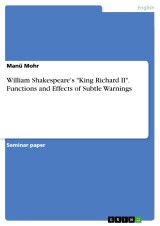Details

William Shakespeare's "King Richard II". Functions and Effects of Subtle Warnings
1. Auflage
|
CHF 15.00 |
|
| Verlag: | Grin Verlag |
| Format: | |
| Veröffentl.: | 12.08.2013 |
| ISBN/EAN: | 9783656478331 |
| Sprache: | englisch |
| Anzahl Seiten: | 17 |
Dieses eBook erhalten Sie ohne Kopierschutz.
Beschreibungen
Seminar paper from the year 2012 in the subject English Language and Literature Studies - Literature, grade: 1,0, University of Stuttgart, language: English, abstract:
King Richard II is a play which has been written around 1595 by William Shakespeare. Due to the fact that there are references to the following works Henry IV Part 1 and Part 2 as well as Henry V, and that these four plays represent a closed period in English history, scholars refer to them as 'the tetralogy' or 'the Henriad'. The author's main source was R. Holinshed's
Chronicles of England, Scotland, and Ireland from 1587, to which he also added some aspects while changing or leaving out others. Shakespeare focuses on the conflict between Richard and Bolingbroke who conspires against the king and finally becomes King Henry IV. From the very beginning, we can find speeches, situations, and images hinting at something horrible that will
happen. It is the aim of this term paper to examine them in greater detail in order to show how the dark atmosphere is created and why the protagonist King Richard II fails to recognize all warnings from people in his surroundings.
First, I will talk about the functions and effects which subtle warnings throughout a play can have. In my opinion, they are important features, so I agree with Wolfgang H. Clemen who also thinks that “[i]t is strange that the role of anticipation and foreboding in Shakespearian [sic] drama has so far not received adequate attention and treatment” (25). Next, I am going to show act by act what is revealing of the king's cruel fate. The conclusion at the end will sum up where the most important warnings have been, and what other questions are approached in the play. Finally, I quote my primary and secondary sources.
King Richard II is a play which has been written around 1595 by William Shakespeare. Due to the fact that there are references to the following works Henry IV Part 1 and Part 2 as well as Henry V, and that these four plays represent a closed period in English history, scholars refer to them as 'the tetralogy' or 'the Henriad'. The author's main source was R. Holinshed's
Chronicles of England, Scotland, and Ireland from 1587, to which he also added some aspects while changing or leaving out others. Shakespeare focuses on the conflict between Richard and Bolingbroke who conspires against the king and finally becomes King Henry IV. From the very beginning, we can find speeches, situations, and images hinting at something horrible that will
happen. It is the aim of this term paper to examine them in greater detail in order to show how the dark atmosphere is created and why the protagonist King Richard II fails to recognize all warnings from people in his surroundings.
First, I will talk about the functions and effects which subtle warnings throughout a play can have. In my opinion, they are important features, so I agree with Wolfgang H. Clemen who also thinks that “[i]t is strange that the role of anticipation and foreboding in Shakespearian [sic] drama has so far not received adequate attention and treatment” (25). Next, I am going to show act by act what is revealing of the king's cruel fate. The conclusion at the end will sum up where the most important warnings have been, and what other questions are approached in the play. Finally, I quote my primary and secondary sources.
Diese Produkte könnten Sie auch interessieren:

American Consumer Culture and its Society: From F. Scott Fitzgerald`s 1920s Modernism to Bret Easton Ellis`1980s Blank Fiction

von: Johannes Malkmes

CHF 64.99
















